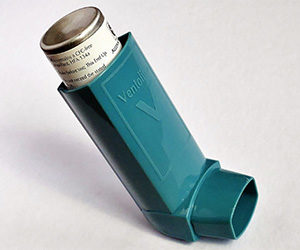Asthma Symptoms and Triggers

Asthma is a disease that affects your lungs. It causes wheezing, shortness of breath, chest tightness, and coughing. All of the causes of asthma are unknown, but we do know that genetics, and environmental and occupational factors have been linked to developing asthma.
If someone in your immediate family has asthma, you are more likely to have it. Exposure to things in the environment like mold, dust mites, and secondhand tobacco smoke has been linked to developing asthma. Also, air pollution and viral lung infections may lead to asthma.
When an asthma attack occurs the sides of the airways in your lungs swell and the airways shrink. This causes less air to get in and out of your lungs which causes coughing, chest tightness, wheezing, and trouble breathing.
An asthma attack can occur when you are exposed to asthma triggers. Asthma triggers vary from person to person. Some of the most common triggers are tobacco smoke, dust mites, outdoor air pollution, cockroach allergen, pets, mold, smoke from burning wood or grass, and certain infections like the flu. It is very important for individuals with asthma to know their triggers and learn how to avoid them.
Please speak with your healthcare provider to learn how to control your asthma.
What is Gout?

Gout is a common form of inflammatory arthritis that is very painful. It often affects one joint at a time. There are no cures for gout but you can treat and manage the condition.
What Causes Gout?
It is caused by a condition known as hyperuricemia, where there is too much uric acid in the body. The body makes uric acid when it breaks down purines which are found in your body and in the foods you eat. When there is too much uric acid in the body, uric acid crystals build up which can cause gout.
Gout flares can occur suddenly and last for weeks. Gout is often found in the big toe but can frequently occur in the knee and ankle.
Signs and Symptoms of Gout
- Intense joint pain
- Swelling
- Redness
- Warmth
What Increases your Chances of Gout?
- Being male
- Obesity
- Taking diuretics
- Having certain health conditions
- Congestive heart failure
- High blood pressure
- Diabetes
- Poor kidney function
- Consuming food or drinks high in fructose
- Consuming purine-rich food
- Red meat
- Organ meat
- Anchovies
- Sardines
- Mussels
- Scallops
- Trout
- Tuna
Gout Treatment
Gout can be treated and managed with medical treatment and self-management strategies. Speak with your healthcare provider for a recommended treatment plan.
Dr. Ashley Fuentes is the Newest Doctor to Join Our Practice

Dr. Fuentes attended Case Western Reserve University for her undergraduate studies and received her Bachelor’s degree in Biology with a minor in Sports Medicine, Chemistry, and Psychology. She then received a Master of Science in Biomedical Sciences from Touro College New York. She obtained her medical degree from Ohio University Heritage College of Osteopathic Medicine in 2016.
Dr. Fuentes completed her Family Medicine Residency training at University Hospitals Parma Medical Center and Cleveland Medical Center in June 2019 and is eager to start practicing. Although she will be doing both outpatient and inpatient general Family Medicine, she has a special place in her heart for osteopathic manipulative treatment, obesity medicine/weight loss management, women’s health, sports medicine, and pediatrics. She also believes in supporting patients to be their own best advocates.
She is originally from Spanish Harlem in New York City, but moved to northeast Ohio in 2005. For leisure, she enjoys boxing, lifting weights, cooking, hiking, and spending time with her husband, family, and friends. She has two dogs, Pepper and Tonka.
Her full bio can be found under our “Staff” section of the website.
Stroke – Signs and Risk Factors

A stroke is when something blocks blood flow to part of the brain or when a blood vessel in the brain bursts. This can cause brain damage, disability, and even death. Stroke is the fifth leading cause of death in the United States. High blood pressure, smoking, and having a history of a stroke increase a person’s chances of having a stroke.
Signs of a Stroke
- Sudden numbness or weakness of the face, arms, or legs
- Sudden confusion or trouble speaking or understanding others
- Sudden trouble seeing in one or both eyes
- Sudden trouble walking, dizziness, or loss of balance/coordination
- Sudden severe headache with no known cause
Risk factors for Stroke
The following common health conditions can increase your risk for having a stroke:
- High blood pressure
- High cholesterol
- Heart Disease
- Diabetes
- Sickle Cell disease
The following lifestyle choices can increase your risk for having a stroke:
- Unhealthy diet
- Physical inactivity
- Obesity
- Too much alcohol
- Tobacco use
A stroke is very serious and requires emergency medical care. Call 911 immediately if you or someone else is showing signs of a stroke.
Skin Cancer – Know the Facts

Skin cancer is the most common form of cancer in the US. Skin cancer is caused by overexposure to ultraviolet light (UV). Ultraviolet light comes from the sun, tanning beds, and sunlamps. Exposure to UV light can cause sunburn, changes in skin texture, premature aging of the skin, and skin cancer.
You are at greater risk for skin cancer if you have:
- A lighter skin color
- Skin that burns, freckles or reddens easily
- Blue or green eyes
- Blonde or red hair
- Large number of moles
- Family or personal history of skin cancer
Symptoms of skin cancer:
Changes in your skin are the most common symptom of skin cancer such as a new growth, a sore that doesn’t heal, or a change in a mole.
Speak with your physician if you notice changes in your skin.
Protection from UV rays:
- Stay in shaded areas
- Wear a wide brim hat
- Wear long sleeves and pants
- Wear sunglasses
- Use sunscreen (SPF 15 or higher) reapply every two hours when in the sun and after swimming or sweating
- Avoid tanning beds
Image by Karolina Grabowska from Pixabay
